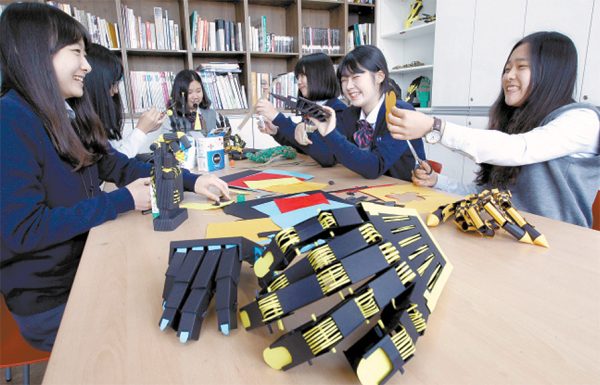Creative management schools a new option

Students at Songgok Girls’ High School make hand figures using corrugated cardboard and glue on Oct. 29. The class is aimed at improving their understanding of the human body and their observation abilities. By Kim Seong-ryong
At the time, it was too late for Ryu to take the entrance exam for an arts high school. With just one month left until the test, she didn’t feel like she was adequately prepared.
But she had another option. When Ryu entered high school in 2011, she enrolled at Songgok Girls’ High School, a public creative management school for the arts that runs two art-focused classes.
“Students who want to apply for a college of arts usually rely on private academies, which is a pity [because they can be expensive],” said Lee Sang-jun, the principal of Songgok Girl’s High School. “I wanted to provide them with high-quality art education within the boundaries of public education.”
Compared to private academies, which can cost around 600,000 won ($564) per month, Songgok Girls’ High School offers after-school classes for 230,000 won. These types of schools are becoming increasingly popular among students who want specialized education but may not be able to afford private education, or students just looking to supplement their studies.
Songgok Girls’ High School has three teachers and 11 instructors who specialize in fine art, and students learn basic principles and techniques in addition to their nine hours of regular daily education. Those who choose can also participate in after-school courses, which run from 6 p.m. to 10 p.m. four times a week.
“We stress the importance of creativity, not just techniques and experiences outside of school,” said Song Hye-jung, who heads the art department. “We have painted the walls [of the school] together with the local residents, [among other projects].”
The curriculum here is different from that of private academies, which largely teach in accordance with the college entrance exam, and student satisfaction is high.
“Out of the 30 students in our class, only five of them go to private academies,” said Kim Do-ha, a first-year student at the school. “In private academies they teach you how to mimic, but in school we learn real art.”
Waiting for the results of early admission from Seoul National University and Hongik University, Ryu is not fazed.
She doesn’t envy those who made it into a private arts high school, she admitted. “Because we’re learning from the same teachers who instruct our regular classes and after-school classes, our basic abilities in art improved quickly,” said Ryu.
This year, there are about 1,663 schools operating as creative management schools, and 625 schools - about 37.6 percent - are running as so-called curriculum-renovation schools, which have adopted new models in teaching English, math, science, the arts and physical education.
Jangan High School in Busan, one such high school, has let its students participate in 54 science experiments since 2010 - and the students are able to conduct experiments in the textbook on their own. “During vacation or after school, students who wish can even take intensive courses like advanced physics or advanced math,” said No Young-hee, the head teacher of the natural science department.
In one specialized education class, which is part of a program in association with the Ulsan National Institute of Science and Technology, high school students can conduct research under a professor for a one-year term.
In 2012, according to the Korean Educational Development Institute, 100 science-focused schools, including Jangan High School, showed an increase in satisfaction by 7 percent.
These alternative programs, educators say, are helping students thrive.
At Maetan Middle School, an English-focused school, students are required to read 15 different English books before graduating.
There, first-year students interact with their English teacher in the United States through a smartphone application. And second-year students are preparing an English-language play.
“These assignments - like writing letters to the authors or making posters for the books - have really peaked students’ interest,” said Lee Seung-yeon, who heads the English department.
BY CHUN IN-SUNG [enational@joongang.co.kr]










with the Korea JoongAng Daily
To write comments, please log in to one of the accounts.
Standards Board Policy (0/250자)